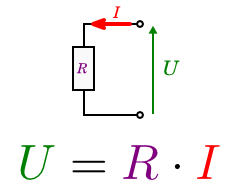Categories: Featured Articles » Novice electricians
Number of views: 48396
Comments on the article: 4
About Ohm's law in a popular statement
Electrical current and hazardous voltage cannot be heard (except for humming high-voltage lines and electrical installations). Live parts under voltage do not differ in appearance.
It is impossible to recognize them both by smell and by elevated temperature in normal operating modes, they do not differ. But we turn on the vacuum cleaner in a silent and quiet outlet, click the switch - and the energy seems to be taken out of nowhere, by itself, materializing in the form of noise and compression inside a household appliance.
Again, if we plug two nails into the sockets of the outlet and take up with them, then literally with our whole body we will feel the reality and objectivity of the existence of an electric current. To do this, of course, is strongly discouraged.
But the examples with a vacuum cleaner and nails clearly demonstrate to us that the study and understanding of the basic laws of electrical engineering contributes to safety when handling household electricity, as well as eliminating the superstitious prejudices associated with electric current and voltage.
So, we will consider one, the most valuable law of electrical engineering, which is useful to know. And try to do it in the most popular form possible.

Ohm's Law Discovery
In 1827, the German physicist Georg Simon Ohm formulated a law linking the magnitude of the electric current, the electromotive force of the battery and the resistance of a simple electric circuit made up of a battery and the poles of heterogeneous conductors connected in series. In addition, he found that various substances have different resistance to electric current.

Ohm experimentally found that in a serial circuit composed of several sections with conductors of different resistance, the current in all sections is the same, only the potential difference on the conductors is different, which Ohm called "voltage drop".
The discovery of Ohm's law was a very important stage in the study of electrical and magnetic phenomena, which were of great practical importance. Ohm's law and the laws of Kirchhoff discovered later on for the first time made it possible to calculate electrical circuits and formed the basis of the emerging electrical engineering.
Types of Ohm's Laws
1. The differential form of the Ohm's law
The most important law of electrical engineering is, of course, Ohm's law. Even people unrelated to electrical engineering know about its existence. But meanwhile, the question “Do you know Ohm’s law?” in technical universities is a trap for presumptuous and arrogant schoolchildren. The comrade, of course, answers that Ohm knows the law perfectly, and then they turn to him with a request to bring this law in differential form. And then it turns out that a schoolboy or a freshman still has to study and study.
However, the differential form of the Ohm law is practically inapplicable. It reflects the relationship between current density and field strength:
j = G * E,
where G is the conductivity of the circuit; E is the electric current strength.
All these are attempts to express electricity, taking into account only the physical properties of the material of the conductor, without taking into account its geometric parameters (length, diameter and the like). The differential form of the Ohm's law is a pure theory; its knowledge in everyday life is absolutely not required.
2. The integral form of the Ohm's law for a chain section
Another thing is the integral form of recording. It also has several varieties. The most popular of these is Ohm's law for a section of a chain: I = U / R
In other words, the current in a circuit section is always the higher, the greater the voltage applied to this section and the lower the resistance of this section.
This "kind" of Ohm's law is simply a must for everyone who at least sometimes has to deal with electricity. Fortunately, the addiction is quite simple. After all, the voltage in the network can be considered unchanged.
For an outlet, it is 220 volts. Therefore, it turns out that the current in the circuit depends only on the resistance of the circuit connected to the outlet. Hence the simple moral: this resistance must be monitored.

Short circuits, which everyone is hearing, happen precisely because of the low resistance of the external circuit. Suppose that due to improper connection of wires in the junction box, the phase and neutral wires were directly connected to each other. Then the resistance of the circuit section will sharply decrease to almost zero, and the current will also increase sharply to a very large value.
If the wiring is correct, it will work circuit breaker, and if it is not there, or it is faulty or incorrectly selected, then the wire will not cope with the increased current, it will heat up, melt and, possibly, cause a fire.
But it happens that devices that are plugged in and have been worn for more than one hour already become the cause short circuit. A typical case is a fan, the motor windings of which underwent overheating due to jamming of the blades.
The insulation of the motor windings is not designed for serious heating, it quickly becomes worthless. As a result, inter-turn short circuits appear, which reduce the resistance and, in accordance with Ohm's law, also lead to an increase in current.
The increased current, in turn, causes the insulation of the windings to become completely unusable, and not the inter-turn, but the real, full-fledged short circuit occurs. The current goes in addition to the windings, immediately from the phase to the neutral wire. True, all of the above can happen only with a very simple and cheap fan, not equipped with thermal protection.

Ohm's cheat sheet for the chain section:

Ohm's Law for AC
It should be noted that the above record of Ohm's law describes a section of a circuit with a constant voltage. In alternating voltage networks, there is an additional reactance, and the impedance takes on the square root of the sum of the squares of the active and reactive resistance.
Ohm's law for an AC circuit section takes the form: I = U / Z,
where Z is the impedance of the circuit.
But a large reactance is characteristic, first of all, of powerful electric machines and power converting equipment. The internal electrical resistance of household appliances and fixtures is almost completely active. Therefore, in everyday life, for calculations, you can use the simplest form of Ohm's law: I = U / R.
3. Integral notation for the complete circuit
Since there is a form for recording the law for a section of a chain, then there exists Ohm's law for the complete chain: I = E / (r + R).
Here r is the internal resistance of the source of the EMF network, and R is the total resistance of the circuit itself.
There is no need to go far for a physical model to illustrate this subspecies of Ohm's law vehicle electrical system, the battery in which is the source of EMF.
It cannot be considered that the battery resistance is absolute zero, therefore, even with a direct short circuit between its terminals (lack of resistance R), the current will not grow to infinity, but simply to a high value.
However, this high value, of course, is enough to cause the wires to melt and the car skin to ignite. Therefore, the electrical circuits of cars protect against short circuits with fuses.
Such protection may not be enough if a short circuit occurs to the fuse box relative to the battery, or if one of the fuses is replaced with a piece of copper wire. Then there is only one salvation - it is necessary as soon as possible to break the circuit completely, throwing away the "mass", that is, the negative terminal.
4.The integral form of Ohm's law for a section of a circuit containing an emf source
It should be mentioned that there is another variation of Ohm's law - for a section of a circuit containing an emf source:
I = (U + E) / (r + R)
or
I = (U-E) / (r + R)
Here U is the potential difference at the beginning and at the end of the considered chain section. The sign in front of the magnitude of the EMF depends on its direction relative to the voltage.
It is often necessary to use Ohm's law for a section of a circuit when determining the parameters of a circuit when part of the circuit is not available for detailed study and is not of interest to us.
Suppose it is hidden by integral parts of the case. In the remaining circuit there is a source of EMF and elements with a known resistance. Then, by measuring the voltage at the input of an unknown part of the circuit, you can calculate the current, and then the resistance of the unknown element.
conclusions
Thus, we can see that Ohm's “simple” law is far from being as simple as it seemed to someone. Knowing all forms of the integral record of Ohm's laws, one can understand and easily remember many of the requirements for electrical safety, as well as gain confidence in the handling of electricity.
See also at bgv.electricianexp.com
:
